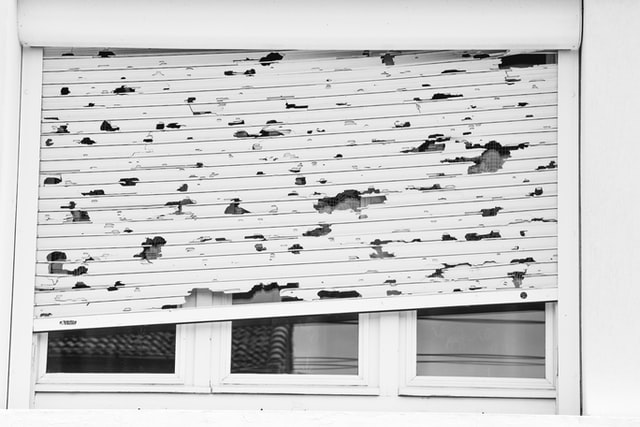
Understanding Hail and Storm Roof Damage
Roof systems are one of the most vital parts of the structure of a home. In addition to keeping people protected from the elements, roofs also protect the structure and mechanical systems. That is why understanding the signs of damage and repairing it before it becomes problematic is critical.
Understanding Home Roof Systems
To the average homeowner, the roof’s exterior may appear to be just a composite of shingles over wood. However, roof shingles do more than rest upon wood; they are supported by sub-roofing over the wood frame structure of the top of a home. This is the primary line of defense for a home’s attic.
When roofing shingles are damaged, the initial problem may only affect the surface area of the shingle. However, with more extensive damage, roof tiles can impact the sub-roofing and the wood sheathing below. Initial damage to tiles may be minor. However, over time, if the damaged roof tiles go unreplaced, the roof can show signs of substantial deterioration and potential for weather element infiltration.
When roof tile damage permeates the structure of a roof system, water, moisture, dirt, and other elements can begin to infiltrate the roof, causing significant damage to the wood in the attic area. Plant bacteria and plant moss can also start to grow under uplifted roof tiles. Water permeation can cause mold, mildew, and wood rot which can adversely affect the integrity of the sub-roofing, attic, and structure. Keeping up with regular roof checks after a storm can prevent further damage.
Recognizing The Signs of Storm Damage
One of the most significant impacts on roofing systems is storms. While aging, extreme heat, sun, and extreme cold can affect roof shingles and make them age prematurely, damage to roofing shingles most often occurs from intense storm systems. These systems are often accompanied by high winds, heavy snow, torrential rain, flying debris, and hail. Storm damage to homes is the number one reason for homeowner insurance claims in the United States.
When an intense storm system strikes, the damage to a roof may not always be evident without a closer view. However, there are certain tell-tale signs that the roof has suffered some level of damage either from wind, heavy snow, flying debris, tree branches, torrential rain, or hail. Whenever there is concern or doubt about the integrity of a roof system after a major storm, it is advisable to have the roof inspected to ensure there is no significant damage.
A roof may appear undamaged from a far-off standpoint, but the damage may become much more evident when inspecting from the roof. Having a professional inspect the roof may be wise for people who have multi-level homes since falls from rooftops are a significant hazard.
When assessing their roofs, homeowners who want to complete a Do-It-Yourself inspection should always keep a few things in mind. Damage caused by flying tree limbs and large flying debris is often noticeable from a basic visual inspection without going onto the rooftop. Shingles will often appear displaced with punctures into the roof tiles, sub roofing and attic are often noticeable. However, roof damage by hail is a little more complex and should be understood by homeowners as a potential masked risk.
Signs of Hail Damage
Hail is one of the biggest causes of roofing and home damage in America. Hail can come in a wide variety of sizes and can strike roofs, windows, and other parts of a home with intense velocity causing significant harm. For storms with substantial amounts of larger hail where the diameter is larger than a dime, the damage is often readily visible. This is also true if the hail storm was particularly violent and lasted over an extended period.
For more subtle hail storms, the destruction may not be as readily noticeable. Before a roof check, homeowners should inquire with a roofing specialist and ask, “what does hail damage look like on a roof?” to get a better understanding of the signs of roof tile and sub-roof storm damage.
Not all initial signs of hail permeation indicate that there is significant roof tile injury. It may become more evident if roof leaks appear or tiles suddenly become displaced. Signs that there may be issues of concern to the integrity of the roof system or roof tiles include:
- Puncture Marks
- Dark Spots
- Roof Tile Cracks
- Displaced Roof Tiles
- Broken Roof Tiles
- Uplifted Roof Tiles
- Buckling Roof Tiles
- Holes in Roof Tiles and Sub-Roofing
- Water Leaks
If any of this appears on roof tiles after a hail storm, some tiles will likely need to be replaced. The extent of the damage often depends on the strength and integrity of the tiles that have been impacted.
The critical thing to remember is once hail damage has occurred to roof tiles, it is essential to replace any that show signs of significant damage or wear, such as punctures, displacement, and cracks. These tiles will lead to a much greater risk of water leaks and the potential for mold, mildew, and moss growth inside the home.
The good news is repairs and replacement of tiling from hail and other severe storms are most often covered by a homeowners insurance policy. Through the help of a professional roofing company (like Presidio Roofing!), homeowners who have suffered hail damage can be confident their roof damage is repaired correctly. Doing this in a timely way will prevent further damage to the sub-roofing, the roof frame, as well as prevent water, mold, mildew, and moss growth penetration into the home.





